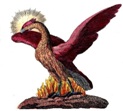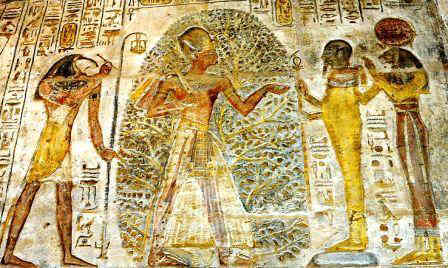
| The Tree of Life | 
|
|
Ancient Egyptian Gods and Goddesses for kids - The Tree of Life The history of ancient Egypt and the significance of the Tree of Life (sacred Ished Tree) |
|
The Tree of Life
Discover the history and religious beliefs surrounding the 'Tree of Life' which was one of the most important religious Egyptian Symbols in the mythology of ancient Egypt. The sun temple located in the City of Heliopolis, Egypt, was dedicated to Ra, the Supreme Solar God, and housed the Tree of Life. The holy Tree of Life was also referred to as the sacred Ished Tree, identified with the Persea Tree. The fruit of the Tree of Life gave Eternal Life and the Knowledge of the Divine Plan, a map of destiny. The fruit of the Tree of Life was not available to mortals, only in the rituals relating to eternity in which the gods refreshed aging Pharaohs, which further symbolized the Pharaohs unity with the gods. The Tree of Life was a prophetic puzzle and it was the Seat of the mythical Bennu Bird (phoenix). |
|
Facts about the ancient Egyptian Tree of Life
The Tree of Life was a potent ancient Egyptian symbol and icon in the mythology and legends of Egypt. According to ancient Egyptian mythology the mythical Tree of Life the fruit of which provided eternal life and knowledge of the cycles of time.

The Tree of Life Fact File
| | Name: | The 'Tree of Life' is also referred to as the sacred, mythical Ished tree has been identified with the Persea, Lebbek, Tamarisk, Acacia and sycamore trees
| | Location of the Tree of Life: | The Tree of Life was located in the Sun Temple of Atum Ra at Heliopolis. The sacred Ished tree of life first arose when Ra Atum, the Sun-god, first appeared at Heliopolis.
| | Significance: | The sacred Tree of Life is connected with the creation myth and the nine gods of the Ennead of Heliopolis
| | Symbol: | The Tree of Life was was one of the most potent symbols of ancient Egypt symbolizing Knowledge of the Divine Plan or the equivalent to a map of destiny.
| | Fruit: | Eating the fruit of the sacred Ished tree of life was a guarantee of eternal life
| | Symbolic Connections: | The Tree of Life is strongly associated with ancient mythology and legends relating to the Bennu Bird and the Djed. |
|
|
Facts about the Tree of Life in Egyptian Mythology
Discover interesting information and research facts about the Tree of Life, the potent Egyptian symbol. The facts about the Tree of Life provides a list detailing fascinating additional info to increase your knowledge about the Tree of Life in Egyptian Mythology and history. 
Facts about the Tree of Life from Mythology and Egyptian History |
Fact 1: |
The Ished Tree of life had a particular solar meaning being associated with the rising sun and as the personification of the Sun god Ra.
| | Fact 2: | The Tree of Life was housed in an open court yard in the Sun temple of Ra in Heliopolis together with the mysterious Ben-Ben Stone, the pyramid-shape capstone that topped a sacred Obelisk.
| | Fact 3: | The Egyptian Tree of Life was protected by the Great Cat (believed to be Mau), a personification of Ra.
| | Fact 4: | During the Ancient Egyptian coronation ceremony, which the ritual of 'Raising a Djed Pillar' was re-enacted, the names of each pharaoh were required to be inscribed on the leaves of this tree.
| | Fact 5: | Thoth, the secretary of the sun god Ra and scribe of the Underworld, wrote the king's name and the length of his reign on its leaves and fruit which protected the ruler and perpetuated his name.
| | Fact 6: | Eating the fruit of the sacred Ished tree of life offered by the gods was a guarantee of eternal life
| | Fact 7: | The Tree of Life was believed to hold the Knowledge of the Divine Plan or the equivalent to a map of destiny which existed from when the world was created, marking the beginning of time
| | Fact 8: | The Egyptian Tree of Life was the home of the Bennu Bird (Phoenix) and was believed to represent the soul of the Sun-God Ra and symbolized resurrection and the rising sun
| | Fact 9: | According to ancient Egyptian mythology the Sun god Ra was said to have split the Ished tree of Life in the morning after his victory over his enemies.
| | Fact 10: | In ancient Egyptian mythology, the first Ennead of Heliopolis were said to have emerged from the Tree of Life, "...in which life and death are enclosed."
| | Fact 11: | Later myths tell a story in which the evil god Set killed Osiris, put him in a coffin which he threw into the Nile. The coffin became embedded in the base of a tamarisk tree of life, which became a pillar in a king’s palace. The 'Raising the Djed Pillar' ceremony symbolized the rebirth of Osiris.
| | Fact 12: | Texts of the creation myth tell that the Tree of Life grew out of the Sacred Mound, it's branches reached out and supported the star and planet studded sky, while it's roots reached down into the watery abyss of the Netherworld
| | Fact 13: | The trunk of the Tree of Life represented the World Pillar or Axis Munde (meaning "Axis of the Mound") around which the heavens appeared to revolve. The World Pillar was the centre of the universe.
| | Fact 14: | The source of four rivers is believed to be located at the foot of the Tree of Life, providing water the world. The four rivers are oriented according to the cardinal points of the compass and are associated with the four elements:- Water - North
- Fire - South
- Air - East
- Earth - West
| Facts about the Tree of Life from Mythology and Egyptian History |
|
|
Bennu- Interesting research information and Facts about the ancient Egyptian Tree of Life
- The sacred bird of the ancient Egyptians
- Egyptian Mythology associated with the Tree of Life
- Facts and information about the gods and deities of of classical Egypt for schools, research and kids
- Pictures, Description and fact sheet for kids
|
| | |
|

The Tree of Life Picture of the Tree of Life
The picture of the Tree of Life depicts a scene from the tomb of Ramses II in which his name is recorded and inscribed on the leaves of the tree of life - The ever youthful figure pictured in the Tree of Life is the Pharaoh Ramses II, depicted with his symbols of kingship: crown, flail and scepter
- The figure to the left is the ibis headed god Thoth who was the god of wisdom, magic, and the measurement, and regulation, of events, and of time. He was the secretary of the sun god Ra and scribe of the Underworld and inscribed the name of the Pharoah on the Tree of Life
- The first god on the right of the picture is Ptah, the lord of truth and master of justice who was present at the ceremony of justification in the Hall of the Two Truths
- The goddess on the right of the picture is Tefnut, the lion headed goddess of water, is often depicted on the coffins of the deceased pouring drink from a pitcher, to sustain the souls journeying through the Underworld. She was also one of the 42 judges present at the ceremony of justification
|
|
|
|
|